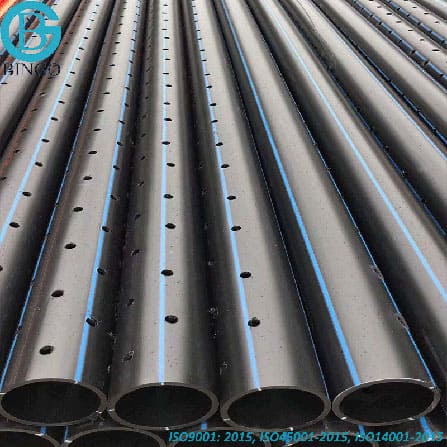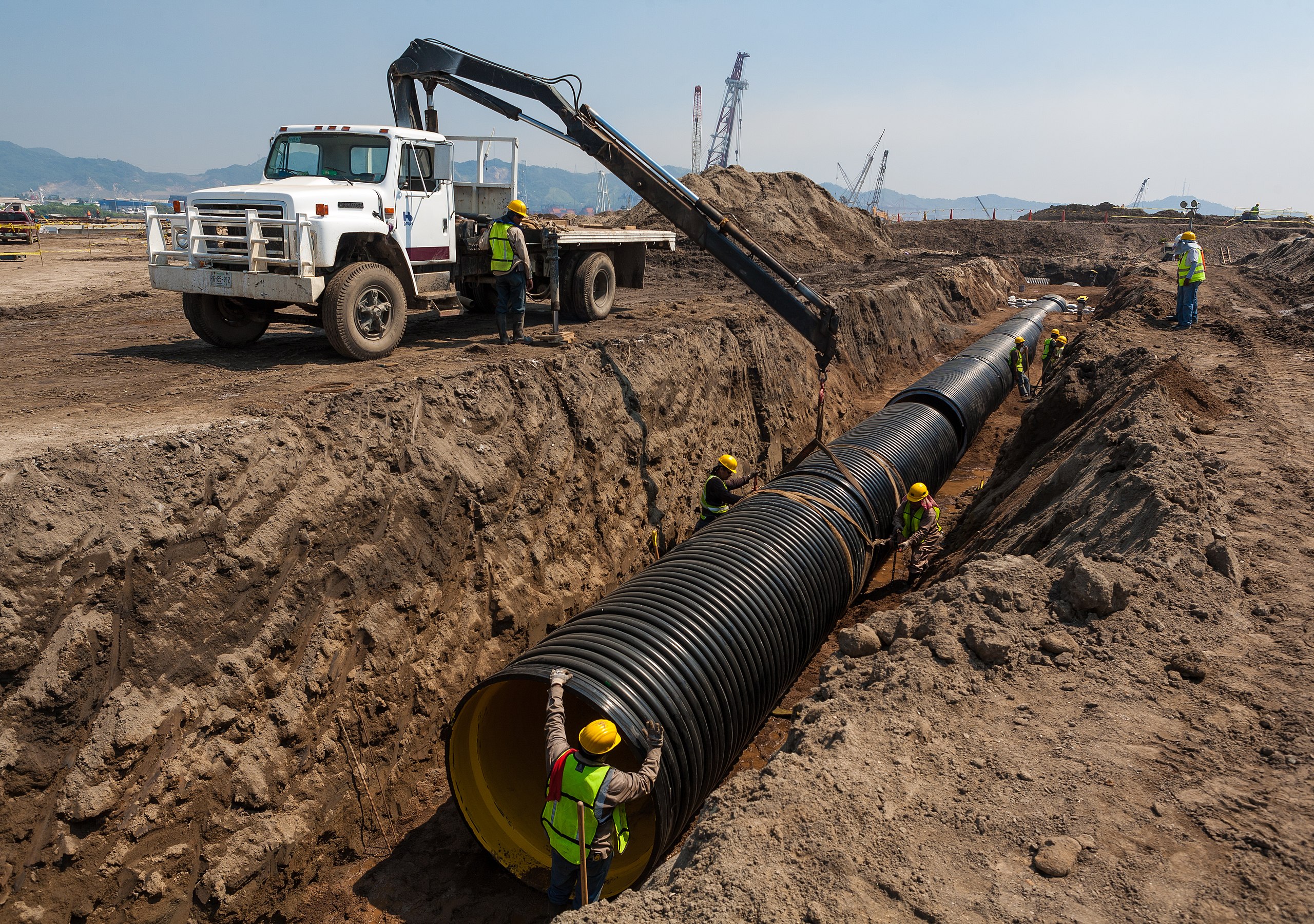How American Plastics HDPE Pipe Manufacturing Maintains Sustainability
The Necessary Steps for Effective Setup of HDPE Pipeline in Your Following Job
Effective setup of HDPE pipeline calls for mindful planning and implementation. Trick actions consist of reviewing task requirements, preparing the site, and choosing appropriate signing up with strategies. Each phase plays a critical duty in making certain the honesty and efficiency of the pipeline. Recognizing these crucial steps can substantially influence the overall success of the project - American Plastics HDPE Pipe for Oilfield. The nuances of each action may hold the secret to conquering typical difficulties encountered throughout installment.
Recognizing the Benefits of HDPE Pipeline
High-density polyethylene (HDPE) pipe provides countless advantages that make it a favored option for different applications. Its high resistance to deterioration and chemicals warranties toughness popular environments, greatly expanding the life-span of installations. In addition, HDPE's versatility allows for much easier setup, particularly in difficult surfaces, as it can bend without breaking. The lightweight nature of HDPE pipeline simplifies transportation and handling, lowering labor costs during installment.
In addition, HDPE pipeline is understood for its reduced rubbing coefficient, which boosts fluid flow and decreases power intake. Its smooth building and construction lowers the danger of leaks, adding to far better source management and environmental security. In enhancement, HDPE is recyclable, lining up with sustainable practices and lowering environmental effect. Overall, the combination of toughness, versatility, and eco-friendliness makes HDPE pipeline a premium selection for a vast array of tasks, from water circulation to commercial applications.
Planning Your HDPE Pipe Setup
When preparing an installation of HDPE pipe, careful factor to consider of a number of essential factors is vital to protect a successful job. Initially, task managers must examine the specific needs of the pipeline, including the planned usage, circulation rates, and environmental conditions. Comprehending these criteria will certainly assist the option of appropriate pipe measurements and material quality.
Next off, timelines should be established, considering procurement routines and any prospective hold-ups. Sychronisation with neighborhood authorities for licenses and governing compliance is additionally necessary. Furthermore, a thorough budget plan ought to be prepared, incorporating all expenses related to products, labor, and machinery.
It is vital to engage a certified team experienced in HDPE pipeline installation. Their know-how will certainly help minimize threats, guarantee adherence to industry standards, and eventually add to the project's success. Thorough planning prepares for a smooth installment process and durable performance of the HDPE piping system.
Preparing the Website for Installment
Correct site preparation is important for the successful installation of HDPE pipeline. Prior to installation begins, the site must be extensively assessed to ensure it meets all necessary demands. This consists of checking the ground for existing structures, energies, and potential dangers that could restrain the installment procedure.

Proper altitude and alignment must be developed to maintain a constant gradient for drain objectives. Proper drainage around the installation site is likewise necessary to avoid water accumulation, which can bring about difficulties down the line.
Methods for Joining HDPE Pipelines
Achieving a trusted link in between HDPE pipelines is crucial for ensuring the honesty and long life of the installment. Different methods exist for joining these pipelines, each fit for different job requirements. Combination welding is one of one of the most usual techniques, making use of warmth to bond the pipe ends together, creating a seamless and durable link. This method can be additional classified right into outlet blend and butt fusion, relying on the pipe arrangements.
Mechanical fittings are one more option, using clamps and threaded adapters to sign up with areas of HDPE pipe. While usually faster to mount, they may require additional maintenance gradually. Electrofusion is a customized technique that entails making use of electrical existing to warm and fuse the pipes through specifically developed fittings, making sure a solid bond. Selecting the suitable signing up with strategy is vital, as it straight influences the total performance and reliability of the HDPE piping system in the desired application.
Testing and Assessment of Installed Pipes
The screening and examination of mounted HDPE pipes are important to guaranteeing their capability and durability. This process includes visual evaluation techniques, pressure testing approaches, and leak detection treatments to recognize prospective problems. By employing these methods, professionals can validate the stability of the setup prior to it is taken into use.
Aesthetic Examination Techniques
Employing efficient aesthetic evaluation techniques is vital for guaranteeing the integrity of mounted HDPE pipes. Inspectors ought to systematically analyze all visible areas of the pipe to identify any signs of damage, imbalance, or inappropriate setup. Key indications to analyze consist of joint integrity, surface abnormalities, and links. Assessors might utilize devices such as amplifying glasses or cameras to boost exposure and information. It is important to look for indications of ecological anxiety, such as distorting or too much flexing, which could compromise efficiency. Constant documents of searchings for enables tracking modifications with time and helps overview essential repair work. By adhering to established visual evaluation protocols, project groups can significantly minimize the risk of future failings and assure long-term integrity of the piping system.
Pressure Examining Techniques
Visual evaluation functions as an initial procedure, yet it is not sufficient on its own to assure the efficiency of installed HDPE pipelines. Stress testing methods are crucial for ensuring the integrity of these systems. Usually, hydrostatic testing is employed, where the pipelines are filled up with water and based on pressure degrees over the designated operating pressure. This method assists identify weak points or potential leakages. Pneumatic screening can also be used, although it brings greater risks due to the compressibility of air. Regardless of the method chosen, sticking to industry requirements and security methods is essential. After carrying out stress tests, complete documentation is necessary to validate the results and confirm that the setup fulfills all functional demands prior to continuing to the next phase of the project.

Leak Discovery Treatments
Just how can one guarantee that installed HDPE pipelines are without leaks? Efficient leakage discovery treatments are crucial to secure direct burial gas line the integrity of the system. Aesthetic evaluations should be carried out, looking for signs of water accumulation or dirt disintegration around pipe joints. Following this, stress testing can confirm the system's toughness. An usual approach is the hydrostatic examination, where water is presented under pressure, checking for decreases that indicate possible leakages. Additionally, progressed innovations, such as acoustic sensing units or infrared thermography, can identify leakages that may not show up. Normal surveillance and maintenance further contribute to the long life of HDPE pipelines, ensuring they continue to be leak-free throughout their functional life expectancy. Correct documentation of these procedures is crucial for compliance and future recommendation.
Upkeep Tips for Long-Term Efficiency
To guarantee the long life of HDPE pipes, developing check out here a routine assessment routine is crucial. This proactive method allows for the early discovery of possible problems, lessening expensive repairs. Furthermore, implementing proper cleaning techniques will assist preserve peak efficiency and stop accumulation that can influence performance.
Routine Examination Schedule
Although HDPE pipes are understood for their resilience and resistance to rust, developing a routine inspection schedule is crucial for guaranteeing their lasting efficiency. Regular inspections aid recognize possible issues such as leaks, joint stability, and environmental effects that may affect the pipe's capability. It is recommended that examinations take place at the very least biannually, or extra frequently in settings with extreme conditions. Texas hdpe pipe manufacturer. During these assessments, aesthetic checks need to be performed to detect my company signs of wear or damages. Additionally, utilizing technology such as ultrasonic screening can supply further insights right into the pipeline's condition. By executing an organized assessment schedule, task managers can proactively address problems, thereby extending the life-span of HDPE pipelines and preserving system efficiency
Proper Cleansing Techniques
Correct cleaning techniques play a crucial duty in keeping the long-lasting performance of HDPE pipelines. Normal cleaning protects against the accumulation of debris, sediment, and biofilm, which can cause obstructions and lowered flow efficiency. Operators must use approaches such as high-pressure water jetting or foam cleansing to effectively eliminate contaminants without damaging the pipe surface. It is vital to prevent making use of rough chemicals that might weaken HDPE product. Additionally, set up upkeep checks ought to include aesthetic assessments for any signs of wear or damages. Effectively trained personnel ought to execute these cleaning processes, making sure conformity with security and ecological regulations. By carrying out these practices, the life expectancy of HDPE pipelines can be greatly prolonged, guaranteeing optimal efficiency throughout their functional life.
Frequently Asked Questions
What Are the Environmental Effects of HDPE Pipeline Production?
The environmental influences of HDPE pipeline production include greenhouse gas exhausts, power consumption during manufacturing, possible plastic air pollution, and challenges in reusing. Nevertheless, HDPE's longevity and resistance to corrosion can minimize some ecological issues.
Exactly How Does HDPE Pipeline Contrast to Various Other Products?

What Tools Are Required for HDPE Pipeline Installment?
Vital devices for HDPE pipe installment consist of a fusion machine, pipe cutters, shovels, measuring tape, and safety and security equipment. Correct tools guarantees effective, risk-free handling and installation, adding to the job's total success and stability.
Exist Any Type Of Specific Regulations for HDPE Pipeline Setup?
Certain regulations for HDPE pipeline installation differ by region, usually governed by regional, state, or federal codes. Conformity with these policies warranties safety and security, environmental defense, and functionality, making adherence vital for successful job results.
Can HDPE Pipes Be Recycled After Usage?
Yes, HDPE pipes can be reused after use. Their thermoplastic nature permits reprocessing, making them appropriate for reusing into new items. This sustainability element contributes to ecological preservation and advertises circular economy methods in building.